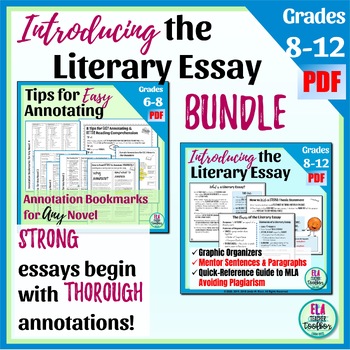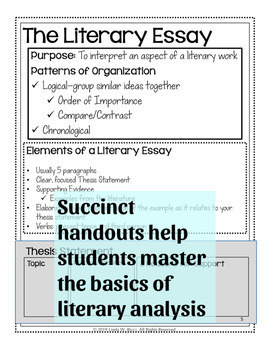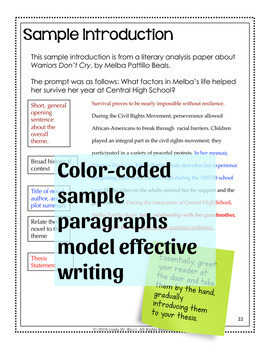Literary Analysis Essay Bundle: Annotations, Essay Samples, Elaboration Practice
- Zip
- Easel Activity
- Easel Assessment
Products in this Bundle (2)
Description
Strong literary essays begin with effective annotating! This bundle includes handouts, graphic organizers, color-coded student essay samples, elaboration practice, and more! From thesis statement to conclusion, this packet makes introducing the literary essay easy!
This product includes 2 PDF files.
Handouts for display and distribution on the following:
✅ What is a Literary Essay?
✅ Elements of a Literary Essay
✅ The Elements of Fiction Overview
✅ What Makes a Good Thesis Statement?
Graphic Organizers and Handouts for the following:
✏️ Thesis Statement
✏️ Evidence Organizer
✏️ Essay Outline with Elaboration
✏️ Compare/Contrast Essay Graphic Organizer: The Outsiders
✏️ Writing the Body Paragraphs with a Color-coded Written Sample
✏️ How to Write an Introduction with a Color-coded Written Sample
✏️ How to Write a Conclusion with a Color-coded Written Sample
Handouts for the following:
✏️ How to Introduce a Quote
✏️ How to Write a Plot Summary
✏️ 3-page Academic Vocabulary Word Bank to "level-up" students' writing vocabulary
✏️ Word Bank of Transition Words
✏️ Revision Strategies
✏️ Writing Problem-solver
✏️ Revision Strategies Checklist
✏️ Sample Rubric
Tips for Easy Annotating includes the following:
- Tried and True Teaching Strategies for Teaching Annotating
- Handout for Students: Why Annotate?
- How and What to Annotate
- 8 Tips for Time-Saving Annotations
- Sample Annotations for The Outsiders
- The Elements of Fiction Overview Handout
- Reader Response Doodle Notes
Plus:
- Four Different Annotation Bookmarks for Any Novel
- Basic Annotations (plot events, questions, surprises, changes in characters, theme)
- Characterization, theme, setting, major plot events, motifs
- Thematic Dialogue, theme, and conflict
- Character, setting, theme, conflict, heroic qualities, changes in characters
Plus:
- Four Different Annotation Bookmarks for Specific Novels
- The Outsiders (Characters, setting, themes, motifs)
- The Giver (Characters, setting, themes, motifs)
- Animal Farm Propaganda, Dramatic Irony, Themes
- Warriors Don't Cry Themes
Plus:
- Graphic Organizers for Character Analysis
- Graphic Organizer for Thesis Statement
***************************************************
You might also be interested in these products for teaching writing:
- MLA Interactive Slideshow
- Research Paper Outlines, Handouts, and Graphic Organizers
- Expository Essay Writing Bundle
- "The Tell-Tale Heart" Writing Activities with Elaboration Practice
**************************************************
Click here to follow my store for updates and special discounts!
Best wishes always,
Linda Ricci
M.A. Education
M.A. Journalism
B.A. English
More than 12 years classroom teaching experience introducing the literary essay
Ten years professional writing experience
Six years experience working for a major educational publisher





